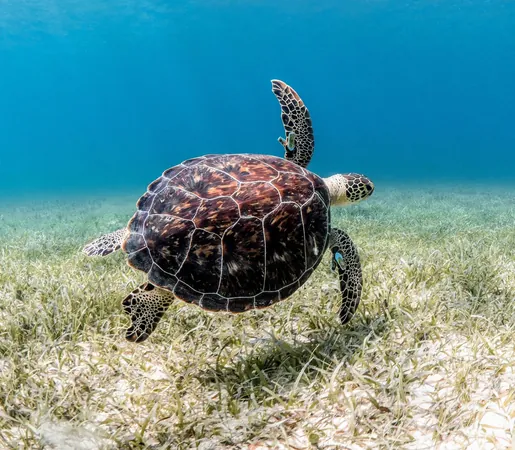
Unveiling the Secrets: Why Sea Turtle Shells are Nature's Marvels
2025-04-11
Author: Li
When we think of sea turtles gracefully gliding through the ocean, we often admire their beautifully streamlined shells. But these shells are not just for protection; they are intricately designed for dynamic survival.
Not only do sea turtle shells provide a sturdy defense, but they also enable these creatures to navigate water with incredible agility, dive to great depths, and withstand the intense pressure changes that come with swimming.
The Anatomy of Resilience
A sea turtle’s shell is made up of two key parts: the carapace on top and the plastron underneath, both shielded by tough keratin plates known as scutes that are fused to the bone. The internal structure resembles a sandwich, with a robust outer layer guarding a lightweight, spongy core. This unique architecture strikes a perfect balance between strength and buoyancy, ensuring vital organs are well-protected.
In-Depth Research on Sea Turtle Shells
Researchers at Florida Atlantic University took the initiative to investigate the remarkable mechanics behind sea turtle shells, as previous studies largely overlooked marine turtles in favor of their freshwater and terrestrial relatives. Their focus was on three North Atlantic species: green turtles, loggerheads, and Kemp’s ridleys.
Employing advanced compression tests and sophisticated statistical models, scientists examined how the structure of these shells evolves throughout the turtles' lives—from hatchlings to mature adults.
Dynamic Design: A Shell Beyond a Shield
The findings, published in the Journal of Experimental Biology, revealed that sea turtle shells are not just passive barriers; they function as sophisticated survival tools. The bone architecture within each shell maintains an exceptional balance of flexibility and rigidity. This means they can absorb shocks from predators while allowing the turtles to remain agile in an aquatic environment.
Interestingly, each of the three species shares a similar shell type yet responds differently to underwater pressures. Green turtles boast the most robust shells, crafted from denser bone, while loggerheads have less densely packed shells that are more elastic. This adaptation serves to mirror the habitats each species occupies and the specific challenges they face.
Growing Stronger: Evolution in Action
As green turtles and Kemp’s ridleys mature, their shells typically become stiffer and stronger, enhancing their protection. Kemp’s ridleys quickly develop this added sturdiness, likely due to their life in more perilous coastal waters.
In contrast, loggerheads don’t exhibit a marked increase in stiffness, which aligns with their tendency to roam the open ocean—a less threatening environment—before approaching shore.
Comparing Seas and Lands: Shell Flexibility
The team also drew comparisons between the shells of sea turtles and those of land turtles, noting fascinating similarities. In both instances, a porous internal bone layer plays a crucial role, allowing for resistance against crushing forces while remaining lightweight and somewhat flexible.
Dr. Jeanette Wyneken, a biological sciences professor at FAU, noted that adult sea turtles’ shells are surprisingly compliant when compared to their terrestrial relatives. Although these shells strengthen over time, they never become entirely rigid, which is essential for thriving in the tumultuous underwater landscape.
Why Sea Turtles Endure
The research underscores why sea turtles have survived for millions of years. As explained by Dr. Marianne Porter, their shells are fine-tuned for their aquatic environments—strong enough to fend off predators while also capable of absorbing impacts. This perfect marriage of strength and flexibility exemplifies how evolution crafts species to succeed in their natural habitats.
From the outside, a sea turtle’s shell may seem straightforward, but its internal design is precisely engineered by nature—ensuring these remarkable ocean dwellers remain safe, swift, and powerful.



 Brasil (PT)
Brasil (PT)
 Canada (EN)
Canada (EN)
 Chile (ES)
Chile (ES)
 Česko (CS)
Česko (CS)
 대한민국 (KO)
대한민국 (KO)
 España (ES)
España (ES)
 France (FR)
France (FR)
 Hong Kong (EN)
Hong Kong (EN)
 Italia (IT)
Italia (IT)
 日本 (JA)
日本 (JA)
 Magyarország (HU)
Magyarország (HU)
 Norge (NO)
Norge (NO)
 Polska (PL)
Polska (PL)
 Schweiz (DE)
Schweiz (DE)
 Singapore (EN)
Singapore (EN)
 Sverige (SV)
Sverige (SV)
 Suomi (FI)
Suomi (FI)
 Türkiye (TR)
Türkiye (TR)
 الإمارات العربية المتحدة (AR)
الإمارات العربية المتحدة (AR)